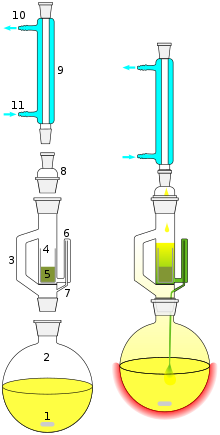1.
Method
Overview
·
[A] Sample Preparation
·
[B[ Soxhlet extraction
·
[C] Silica gel cleanup
·
[D] Kudema-Danish (K-D) volume reduction
·
[E] GC-MS SIM (Selective Ion Monitoring)
mode analysis
2.
Materials
& Apparatus
[A] Air sampling cartridge with
AIRCON pump
Internal Standard (naphthalene-d8, acenaphthene-d10,
phenanthrene-d10,
chrysene-d12,
and perylene-d12)
[B] 10% ethyl ether in hexane (GC
grade)
Methylene chloride (GC grade)
Soxhlet extractor
[C] Silica gel (100-200 mesh,
Davisil Grade 644)
Chromatographic column (11 x 300 mm)
[D] Kudema-Danish (K-D)
concentrator
Nitrogen
supply
[E] GC-MS instrument coupled with
PTV injection system and SVE-COC column
3.
Procedure
[A]
Sample Preparation
Place 3 air sampling cartridge
inside the gent’s toilet close together, each of the sampling cartridges contains
3 cm polyurethane foam (PUF) that holds XAD-2 resin trap in place. (XAD-2 resin serves to trap the sample analyte PAHs
in the atmosphere) An AIRCON pump is coupled with the cartridge as it is used
to draw air through the cartridge at a flow rate of 10 L/min for 48 hr. Spike
the cartridge with exactly 2ul of the internal standard (24ug/mL of each
component) after starting the pump.
{Explanation: Large
volume (28,800L) of air is driven through the cartridge as the concentration of
individual PAHs in air is usually very low (and it can be as low as a few pg/m3). The efficiency of the
resin trap also has to be taken into account, since it is not 100% effective;
using a larger volume of air would ensure that any error due to its
inefficiency can be minimized}


[B] Sample extraction (Soxhlet extraction)
The
sample collected on the cartridge is extracted by refluxing on Soxhlet extractors
using 10% ethyl ether in hexane for 24 hr followed by two subsequent 24-hr
extractions using methylene chloride. After the extraction, combine the
extract.
{Explanation:
Typically, Soxhlet extraction is used when the desired compound has a limited
solubility in a solvent, and the impurity is insoluble in that solvent. In the
first cycle of Soxhlet extraction, the solvent is introduced through the
condenser where it will fill a thimble that holds the sample containing the
slightly soluble analyte and insoluble impurities. The solvent is added till
before it overflows, then a siphon side arm would drain the solvent containing
the analyte into a distillation flask. Meanwhile the distillation flask is
heated to vaporize the solvent; the vaporized solvent is condensed as it reaches
the condenser and drips back into the thimble.
After
many cycle, the desired analyte is concentrated in the distillation flask,
which is prudent as aforementioned the concentration of individual PAHs found
in air is extremely low thus it’s necessary to concentrate the analyte.}


[C] Sample cleanup (Silica Gel Fractionation Chromatography)
Using the chromatographic column
(11 x 300 mm) with 100% activated silica gel, run the column with the Soxhlet
extract together with the eluting solvent (hexane), highly polar sample components
are irreversibly retained in the column. The aliphatic fraction is first eluted with hexane,
and then the aromatic fraction is eluted with 50% DCM in hexane later.
{Explanation: Silica Gel
Fractionation Chromatography is used to physically separate the sample
components based on their polarity. Its use separates PAHs and polychlorinated biphenyls
(PCBs) into two groups, while simultaneously eliminating most interfering
substances for subsequent instrumental analysis.}
[D]
Concentration (Kudema-Danish volume reduction)
The volume of the sample eluted
from the clean-up column was reduced by K-D to ~4 mL and then further reduced
by nitrogen to 2 mL for instrumental analysis. Fill up the sample vial with the
concentrate.
{Explanation: Before injecting
the sample into the GC system, it first has to be concentrated so that trace
amounts of the PAHs can be detected.}


[E] GC-MS analysis
For GC-MS analysis, we are
using large volume injection by PTV (Programmed Temperature Vaporization) and
SVE-COC column (Solvent Vaporization Exit - Cool on-column). Adjust the
automated injection system to take up 100 μL of the sample concentrate and run it
through the GC-MS SIM mode.
{Explanation:
By increasing the injection volume from 1 or 2 μL by traditional
split/splitless inlet to 100 μL or higher with PTV inlet, analytical sensitivity
is greatly enhanced for analytes with low concentrations. In addition, tedious sample
pretreatment procedures may be simplified by
eliminating
or shortening the solvent evaporation step, which is not only time-consuming
but also subject to chemical loss due to high temperatures or a vacuum.
Alternatively, a lesser amount of sample can be collected for predetermined
detection limits.
In the
SIM mode, the instrument is set to look for only masses of interest in a
specified time range, thus it can be specific for a particular analyte of
interest.}


References
No comments:
Post a Comment